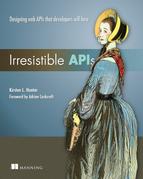Foreword
Building an irresistible API doesn’t only make good business sense—it also makes developers happy and productive rather than grumpy and frustrated. I’m very happy to see Kirsten write this book, which explains how to build well-engineered APIs and explores what makes a developer actively want to use that API.
I’ll begin with a story. It’s September 2008, and Netflix is running a “hack day.” This is a day on which anyone at Netflix can build anything they want. It starts at noon one day and finishes at noon the next. You can work through the night if you need to. The Netflix API team was about to release the initial version of a public API for Netflix and had scheduled the hack day as a way to get extra testing time before the release. The Apple iPhone had been released earlier that year, and the first software developer toolkit for the iPhone had been released that summer. I was a manager at Netflix at that time, but I had started to build an iPhone app in my spare time and decided to build the first ever Netflix mobile app for the hack day.
The odds weren’t looking good. I barely knew the Objective-C language that iPhone apps are written in, and no one else at Netflix had ever used it. The authentication protocol was new and buggy, and I had to improvise some iPhone code to connect to Netflix. I recruited an engineer to help. We spent several hours understanding and debugging the OAuth security protocol. Finally, I got the iPhone to connect successfully and started trying to make sense of the responses from API queries. The API was based on an XML-based standard called AtomPub, and generating the requests was awkward. Parsing them was even more awkward. It was really intended to be used from a web browser, not to support a mobile app. After a late night of coding and a lot of grumbling, I finally had a working prototype. In the afternoon, we all showed our hacks to a panel of judges, and I won a prize. I put it on the App Store, and it was the first public Netflix mobile app. It wasn’t until 2010 that Netflix released official iPad and iPhone apps.
Netflix created a developer program around the public API, and Kirsten was one of the engineers hired to help run the program. In 2010 we both attended an iPad Dev Camp, run like an extended public hack day, and worked together on a Netflix-related iPad app. We were using the Netflix API despite its shortcomings, and I think there was a missed opportunity. Ultimately, the public API was a failure for Netflix, and the company shut it down. Kirsten tells the rest of this story in chapter 1 of this book.
I learned a lot from this experience—and from Kirsten herself. In 2016 this is a very important topic. Many companies need an API to do business. Many are even actively competing with other companies that have alternative APIs. In the past, software products were bought as prebuilt packages and were hand configured. Today software is often chosen by rummaging around on GitHub, trying to figure out which project has the most developer traction, and installation and deployment is automated via APIs. The lack of friction in web service and open source–based business models is there to be exploited by the viral spread of irresistible APIs.
Thank you, Kirsten, for this contribution to making the world a better place.
ADRIAN COCKCROFT TECHNOLOGY FELLOW AT BATTERY VENTURES
